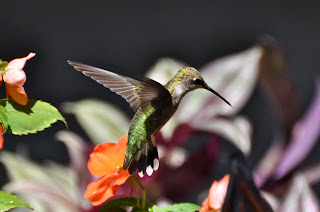young male Broad-tailed Hummingbird
(photo by Dave Patton)
I think most of us can agree that the descriptors “amazing” and “incredible” are among the most overused and misused words in our present-day pop-culture lexicon. I mean, if everything is as amazing and incredible as it's made out to be these days, then why are we in such trouble?
On the other hand, Real things – take Nature for example – are truly amazing and incredible; and one of the most amazing and incredible organisms in all of Nature is the hummingbird. The tiny size, the irridescent plumage, the ability to fly backwards and upside down with itty-bitty wings that beat 60 times a second . . . amazing . . . incredible.
Limited in distribution to the Americas, where over 330 species live, hummers reach their peak species diversity in northern South America, where 150 different species reside in Ecuador alone! As you go north or south from the tropics, hummer diversity drops accordingly. In the U.S., about 25 species have been recorded, 14 of which are regular breeders here, and the remaining 11 “strays” which have made brief appearances from points further south.
female Ruby-throated Hummingbird
(photo by Matt Conn)
Here in Louisiana, we host but one breeder, the Ruby-throated Hummingbird; but in an odd and recent turn of natural events, a dozen additional species have been recorded here to date – almost all of which show up in winter. Wow. Bear in mind that, as a rule, these additional species, as well as our own Ruby-throated, normally/traditionally overwinter down in the American tropics of Mexico, Central and South America.
Beginning back in the 1930s, “winter hummingbirds” began to be reported from the U.S. Gulf Coast, including here in south Louisiana. By the 1980s, the rate of winter hummingbird detections in Louisiana began to swell on an annual basis, with each successive winter bringing more and more birds and species. Pioneering banding efforts by Louisiana's Nancy Newfield and others have proven that many of our winter hummingbirds are actually “returnees,” birds which return here winter after winter, more often than not to the same yard where they were first captured and banded!
adult male Rufus Hummingbird
(photo by Dave Patton)
Today, at least three non-Ruby-throated Hummingbird species populate southern Louisiana in such numbers as to be considered common winter inhabitants: the Rufous Hummingbird from the northwestern coast of the U.S. and Canada, the Black-chinned Hummingbird from the western/southwestern U.S., and the Buff-bellied Hummingbird, a Mexican/south Texas breeder which regularly wanders northward to overwinter along the northern Gulf Coast of the U.S.
The Seasonal Hummingbird Set-up in Louisiana
mama Ruby-throated Hummer on nest
(photo by Skip Miller)
Folks in urban areas and places well-away from water generally see Ruby-throated Hummingbirds only during their migration periods (March-May and August-October) into and through the state. Those of us who live in the woods near rivers, bayous, swamps, and lakes see them regularly throughout their May-August breeding season as well. Peak spring migration numbers occur in April; peak fall migration numbers in September. During those months, almost everyone who hangs a feeder or maintains a nectar plant garden will see large numbers of migrating Ruby-throateds.
Buff-bellied Hummingbird
(photo by Dave Patton)
If you see a hummingbird at any point between late October and early March in Louisiana, chances are it's not a Ruby-throated. Yes, a few Ruby-throateds do overwinter in southern Louisiana, but far fewer than do Rufous, Black-chinned, and Buff-bellied hummers. Additional wesstern U.S. species (listed in decreasing order of abundance) that you might also encounter include Broad-tailed, Calliope, Allen's, Anna's, and Broad-billed, all of which are reported from our state just about every winter. And then there are the super-rare species such as Blue-throated, Green-breasted Mango, Green Violetear, and Magnificent hummers to consider, though to date these have been recorded on only 1-2 occasions in Louisiana. Refer to your bird field guides and/or google to learn more about all these species.
Attracting and Hosting Hummingbirds
First and foremost, you'll need garden space in which to install nectar-producing plants and provide habitat for not only the hummers, but also the tiny insects/invertebrates which comprise up to 25% of their diets. Next blog post, I'll cover hummer plants, so stay tuned.
Equally important for those of us who host hummers for long periods of time (breeding/overwintering Ruby-throats and/or overwintering non-Ruby-throats) are artificial nectar feeders. If you maintain or desire to maintain artificial nectar feeders, understand that you are creating an artificial lifeline to the hummers that you'll host. Thus, you must commit to maintaining these feeders, ensuring that they are clean and contain fresh (changed out every week or so) sugar solution on a daily basis. Do not put red dye in the sugar solution. That ain't necessary and it's probably unhealthy. Do not use honey or any other sweetener besides ordinary table sugar. Acceptable sugar-to-water ratios are 1:4 in the summer months and 1:3 in colder weather (that's like l cup sugar to 3 or 4 cups water). If you're not hosting hordes of hummers, keep your feeders only partially full. It's no use filling them to the top only to have the unused nectar spoil after a week or so. Store unused sugar solution in the fridge.
adult male Black-chinned Hummingbird at da feeder
(photo by Dave Patton)
Maintain as many feeders as you dare, only make the committment to continuously maintain them for the sake of the birds that depend upon them. Once the big slug of migrating Ruby-throated hummers has passed, many of us will take down all but 1-3 feeders.
If you live within the Interstate-10 corridor and southward, DO NOT take your feeders down in attempts to induce Ruby-throated hummers to continue southbound migration during the fall. Ruby-throats must double their body weights in order to make the long trip to southern Mexico, so they need all the feeder help that they can get here in the north. If a Ruby-throated or two linger around your feeders into December, chances are they are too young, too old, or too sick to migrate any further south. Besides, non-Ruby-throated species are actively seeking overwintering sites here from October-February, and they'll definitely need your feeders, particularly when freezing weather has killed off many of the nectar-producing plants in our gardens.
immature male Black-chinned hummer
without lots of practice, most non-adult male hummers
encountered during the winter months will be difficult to identify...
(photo by Dave Patton)
Species identification of adult male hummingbirds is pretty straightforward. Females and immature males, on the other hand, are usually very difficult to identify to species. Only a handful of hummingbird experts are able to routinely identify females and immature males here in south Louisiana during the winter months. Nancy Newfield, a Metairie resident and longtime Louisiana birder, has been studying and banding Louisiana hummingbirds for nearly 35 years. She'll be glad to investigate any winter hummer that might show up in your yard, particularly if you live in southeastern Louisiana. Check out http://www.casacolibri.net/ for info on Nancy (504.835.3882 h, 504.338.3882 c; nancy@casacolibri.net) and Louisiana hummers. Additionally, her new Louisiana Hummingbird publication is now available in both hard-copy and downloadable form at http://www.btnep.org/BTNEP/resources/downloads/publications.aspx. Much of the information that I've related in this post comes from Nancy. Her next speaking engagement will be November 29 at the Bluebonnet Swamp Nature Center in Baton Rouge.
If you live in southwestern Louisiana and find yourself hosting a winter hummer, contact longtime Lafayette birder and hummer bander Dave Patton (337.298.8447; wdpatton@cox.net; see also http://www.pbase.com/pattonpix/humphotos for a look at Dave's fab hummer pics, some of which appear on this post). This coming Saturday (September 15) Dave will be conducting a hummingbird banding demonstration in Lafayette. Contact him or Lafayette's WildBirds Unlimited store for more information.









our older bottle brush bush has attracted a host of newly arrived hummer here in lacombe la. will extensive watering of the bush help it to produce more necture. there are about 12 newly sited birds, and they are very hungry. I have but up another feeder also near the bush.
ReplyDeleteDon Lord..Jackson,La. Sept. 12,2019
ReplyDeleteThanks for sharing all the helpful
tips on helping out our little
ferocious friends. One very aggressive
Type flew right up to my face and
stared eyeball to eyeball near one of
our over taxed feeders. A few days ago
our population mushroomed. Cant keep up with the 4 feeders we have on the porch. They're like "Mighty Mouse
with wings on Steroids" Cant help
but love em'.
Barksdale AFB, for 7 days ,up to two dozen hummers, wearing out the two feeders.Amazing the flight coordination to fill the open slots,then this morning, wind from the north,gone. Back to our 4 regulars.
ReplyDeleteWe only seem to have 4 or 5 and one of them fly within 2 feet of my face and hover there looking at me. I can hardly believe he does that. So darn cute. I bought a hummingbird ring and hope that he or she will eventually feed from my ring. We have 5 feeders now and thinking about getting at least 3 more. Keeps me busy making the sugar water but it is worth every minute of it to have these precious little birds here.
ReplyDelete